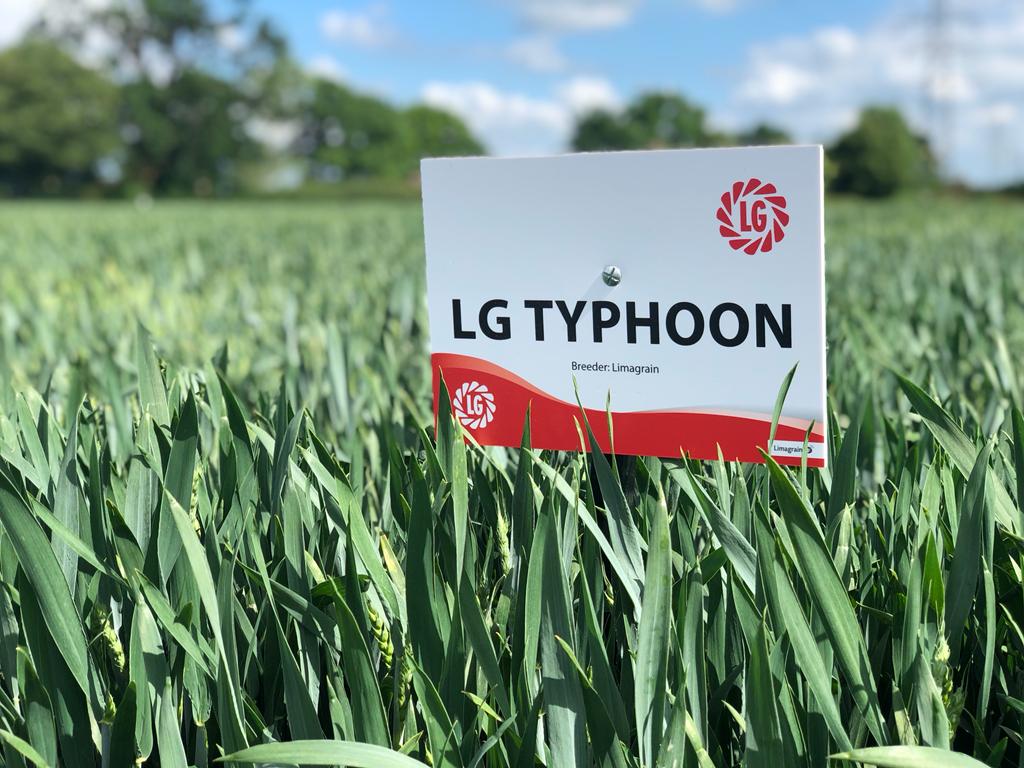Wheat variety ticks all the boxes for regen grower
20th September 2023
With its strong and consistent performance despite high disease pressure, Group 4 winter wheat variety LG Typhoon impressed farm manager Philip Vickers, who is striving to reduce inputs on a large arable farm in the Northeast of England.
Direct drilling was introduced at County Durham-based Raby Estates in 2018 with the aim of building a more sustainable cropping system without compromising on the quality and quantity of crops produced.
It is a challenge that LG Typhoon lived up to last season, according to Mr Vickers, who decided to trial the variety on the recommendation of Limagrain UK’s arable technical manager, Ron Granger.
“We’re trying to move away from growing high input varieties, so are primarily looking for those that offer a robust disease package, good standing power and suitability for our direct drilling system,” Mr Vickers explained.
“Direct drilling in northern England is not something you want to be doing into November, so I also look for varieties that suit the early drilling slot. From what we’ve seen so far, LG Typhoon seems to fit our requirements well.”
Strong performance
Last season, the farm grew around 32 ha (80 acres) of LG Typhoon, alongside several other varieties, but Mr Vickers has been so impressed with its agronomics, ease of management and yield performance, that he plans to increase this to 100 ha for 2023/24.
The variety averaged an excellent 9.4-9.6 t/ha, despite a number of weather-related challenges throughout the season, including exceptionally high Septoria pressure, which did not make for an easy growing season.
LG Typhoon was direct drilled in mid-September as a first wheat after oilseed rape, using the farm’s 6-metre Horsch Avatar, or 6-metre Väderstad Seed Hawk, drills. Seed rates were kept relatively high at around 300/m2, to counter the slightly lower establishment percentage experienced when direct drilling.
All crops received a base application of phosphate and potash fertiliser, plus a total of up to 170 kg N/ha in the spring, applied as three splits; the first as granular urea, followed by two liquid nitrogen applications.
“We have been reducing nitrogen use significantly in recent years, but in contrast to conventional thinking, some crop yields have gone up in that period,” Mr Vickers noted.
“Agronomy-wise, LG Typhoon was problem-free,” he continued. “It established quickly in the autumn, got away well in the spring, and was relatively early to harvest, tight behind Graham.”
But even though it established quickly, he said LG Typhoon did not get too large, unlike some other varieties, which continued tillering throughout a very mild autumn, during which temperatures hit 21°C in November. Those varieties then became much harder to manage with growth regulators and fungicides in the spring.
Robust disease profile
Strong Septoria resistance is a must-have for all winter wheat varieties grown on the farm, as the disease remains the number one yield-robber in high pressure seasons such as 2023, Mr Vickers said. “We generally look for varieties with a Recommended List score of at least six.”
With a Septoria rating of 7.3, backed up by a combination of genetics that are different to those in other RL varieties, giving LG Typhoon a distinct advantage over other varieties.
Although crops received the farm standard fungicide programme, based around Iodus (laminarin) at T0, bixafen/prothioconazole at T1, Univoq (fenpicoxamid + prothioconazole) at T2, and straight tebuconazole at T3, he was able to reduce rates by 10-15% on the LG Typhoon due to its robust disease profile.
“To ease management, we generally try to keep fungicide products similar across all varieties, but will look to vary the rate where appropriate.
“Despite doing so on the LG Typhoon, we still didn’t see any disease of significance at all last season, even though there was very high Septoria pressure which caused some other varieties to struggle.”
Accurate spray timing is also key to maintaining effective disease control, as is a robust trace element programme to bolster plant health and reduce the crop’s susceptibility to disease infection, he added.
Perfect fit for regen systems
Mr Granger said LG Typhoon has certain attributes that make it ideally suited to strip tillage/direct drilling, regenerative crop establishment systems, that often feature wider rows.
LG Typhoon’s growth habit, for example, means plants sit prostrate with slower growth through the winter into spring, which is ideal for those direct drilling earlier in the autumn and who do not want a variety that races off too quickly.
It is a high tillering variety that has the capacity to utilise the space between the wider rows, often found with some direct drilling equipment.
Indeed, while Mr Vickers’s Horsch drill works on a standard row spacing, the Väderstad is at a slightly wider 180-200mm spacing, and he also trialled a new 12-metre tine drill last season, which worked on a wider 250mm row width.
“Unfortunately, we don’t yet have the yield data available, as the demo field was combined by a contractor, but the LG Typhoon did seem to really suit that wider row spacing. It’s something we may potentially look at in the future, although I’m not sure a 12-metre machine is suited to some of the smaller fields on our farm.”
Another attribute of LG Typhoon that makes it a good fit for regenerative systems, and for those looking for flexibility with crop protection inputs, is its strong standing power and disease resistance – reflected by its high untreated yield (92%), Mr Granger said.
Unlike some other feed varieties, it also offers Orange Wheat Blossom Midge (OWBM) resistance, in addition to a six-rating for eyespot and Fusarium.
“It’s a high yielding, consistent and resilient variety, that delivers across seasons and rotations,” he concluded.

